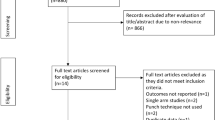Abstract
Drilling a bone and passing a suture through the drilled hole are commonly performed during several surgical procedures. In this study, a newly designed non-electric drill with a hole over its shank is introduced. The hole may carry a suture material through cartilage or bone tissues; thus, it may provide a considerable additional function of suture shuttling. “Ariana finger drill and suture shuttle” consists of four main parts and one specifically designed hole. From distal to proximal, it consists of a perforating tip, a shank, a handle, and a cap at the top of the handle. The device may be operated easily with fingers, and it can perforate the bone without damaging it with pressure or heat. Additionally, the cap of the screwdriver may turn 360°, and it may protect against glove wrap** during continuous rotation movement. “Ariana finger drill and suture shuttle” contains a 0.4-mm hole that is located at the upper end of the perforating tip. This allows the drill to act as a suture shuttle. Bone perforating and suture shuttle features of the device may be used in rhinoplasty, periorbital surgery, temporomandibular joint surgery, hand surgery, and facial rejuvenation surgeries. “Ariana finger drill and suture shuttle” is a non-electric device that may be considered a good alternative for bone drilling and suture passing through the drilled tunnel with a very low cost and a low complication risk.


Similar content being viewed by others
Data Availability
Not applicable to this study.
Code Availability
Not applicable to this study.
References
Trubina AV, Trubin VV, Matveev RS, Golubtsova NN (2019) The reaction of spongy bone tissue to the usage of motor systems in trauma and maxillofacial surgery. Sys Rev Pharm 10(2):114–119. https://doi.org/10.5530/srp.2019.2.19
Arnold MCA, Zhao S, Doyle RJ, Jeffers JRT, Boughton OR (2021) Power-tool use in orthopaedic surgery: iatrogenic injury, its detection, and technological advances: a systematic review. JBJS Open Access 6(4):e21.00013. https://doi.org/10.2106/JBJS.OA.21.00013
Graham SM, Nerad JA (2003) Orbital complications in endoscopic sinus surgery using powered instrumentation. Laryngoscope 113(5):874–878. https://doi.org/10.1097/00005537-200305000-00018
Wells MP (2010) Surgical instruments-e-book: a pocket guide. Elsevier Health Sciences
Messer EJ, Carlson RS, O'Keefe JS, Bill TJ, Luce CA, Thacker JG, Edlich RF (1995) Evolution of powered surgical instruments. J Long-Term Eff Med Implants 5(2):129–146
Abouzgia MB, James DF (1997) Temperature rise during drilling through bone. Int J Oral Maxillofac Implants 12(3):342–353
Bahat O et al (2022) An osteotomy tool that preserves bone viability: evaluation in preclinical and clinical settings. J Clin Med 11(9):2536. https://doi.org/10.3390/jcm11092536
Mediouni M et al (2019) An overview of thermal necrosis: present and future. Curr Med Res Opin 35(9):1555–1562. https://doi.org/10.1080/03007995.2019.1603671
Yasuhara H, Fukatsu K, Komatsu T, Obayashi T, Saito Y, Uetera Y (2012) Prevention of medical accidents caused by defective surgical instruments. Surgery 151(2):153–161. https://doi.org/10.1016/j.surg.2011.06.029
Phillips AJ (2001) Power instrument skills, vol 1. McGlamry's Comprehensive Textbook of Foot and Ankle Surgery, p 17
Jang YJ, Kwon M (2010) Modified extracorporeal septoplasty technique in rhinoplasty for severely deviated noses. Ann Otol Rhinol Laryngol 119(5):331–335. https://doi.org/10.1177/000348941011900510
Botti G, Botti C, Rossati L, Gualdi A, Nocini P, Nocini R, Bertossi D (2019) “Dynamic canthopexy” drill hole canthal repositioning. Aesthet Surg J 39(12):1284–1294. https://doi.org/10.1093/asj/sjz077
Elshamaa MM, Elborolosy SA (2022) Functional outcomes after using the glenoid fossa as a fixed anchorage for the temporomandibular joint discopexy in patients with disc displacement without reduction. J Craniomaxillofac Surg 50(1):26–31. https://doi.org/10.1016/j.jcms.2021.09.010
Huq S, George S, Boyce DE (2013) Zone 1 flexor tendon injuries: a review of the current treatment options for acute injuries. J Plast Reconstr Aesthet Surg 66(8):1023–1031. https://doi.org/10.1016/j.bjps.2013.04.026
Author information
Authors and Affiliations
Contributions
All authors contributed equally in the treatment of the patient, collection of the relevant data, preparation of the manuscript, and revision of the manuscript.
Corresponding author
Ethics declarations
Ethics Approval
The study was consulted to the Institutional Ethics Committee, and ethics approval did not apply to the study according to the Turkish Ethics Committee Regulations.
Consent to Participate
The patients were informed about the study and they consented to the study by signing a form.
Consent to Publication
The patients were informed about the publication and they consented to the study by signing a form.
Competing Interests
The authors declare no competing interests.
Additional information
Publisher’s Note
Springer Nature remains neutral with regard to jurisdictional claims in published maps and institutional affiliations.
Supplementary Information
Video 1 Demonstration of the way of the utilization of “Ariana finger drill and suture shuttle”. (M
Rights and permissions
Springer Nature or its licensor (e.g. a society or other partner) holds exclusive rights to this article under a publishing agreement with the author(s) or other rightsholder(s); author self-archiving of the accepted manuscript version of this article is solely governed by the terms of such publishing agreement and applicable law.
About this article
Cite this article
Çerçi Özkan, A., Kozanoğlu, E. “Ariana Finger Drill and Suture Shuttle” for Bone Perforation: Think Simple!. Indian J Surg 86, 414–417 (2024). https://doi.org/10.1007/s12262-023-03862-5
Received:
Accepted:
Published:
Issue Date:
DOI: https://doi.org/10.1007/s12262-023-03862-5




